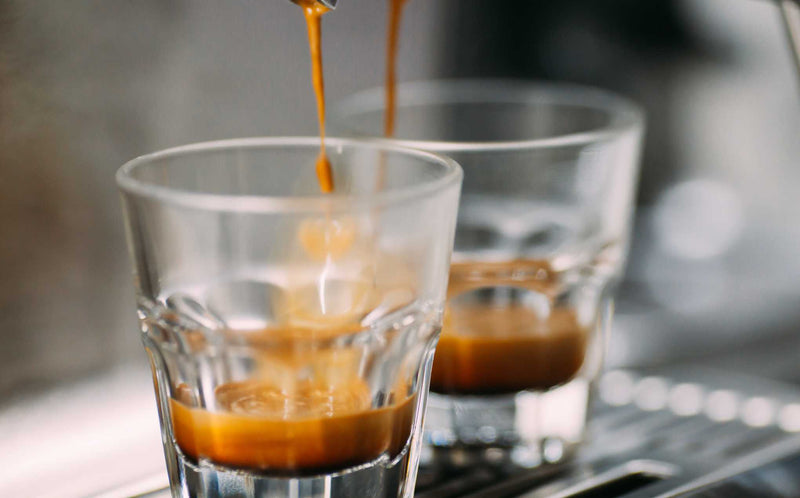Coffee tasting: the lesser-known factors that influence the sensorial experience
In the world of high-quality coffee, every detail counts to deliver a superior sensory experience. When thinking about the factors that can influence the perception of coffee flavor and aroma, we tend to consider traditional aspects such as roasting and extraction. But the material, shape and color of the container in which the coffee is tasted can also play a fundamental role.
In this article, we will tell how the choice of the right container, together with the effect of color, can improve and enhance the perception of the flavor of coffee, opening up new horizons of sensory experience.
Before we start: let's define taste, aroma and flavour
Before getting into the details, it is crucial to understand the key terms:
- Taste (or gustatory) : represents the perception of basic flavors, such as salty, bitter, sweet, sour and umami, in the taste buds when we eat or drink.
- Aroma : is the distinctive odor caused by a complex mixture of volatile compounds.
- Flavour : it is the combination of the perceptions of taste and aroma.
The role of visual perception
The perception of flavor does not only concern the palate but also involves the eyes ( How bitter is coffee? - Rai News ) . The sight of the contents of the container can influence the psychological perception of the flavor even before tasting the coffee. When we see an espresso in the glass, we are predisposed to receive a drink that recalls sensory experiences experienced with similar liquids. This is what psychologists call emotional conditioning.
You can experience this effect with a simple experiment. Place two glasses in front of a friend:
- a glass glass containing an espresso in which you have dissolved 3 teaspoons of sugar.
- another glass cup containing the same espresso, but with the addition of white milk.
Then ask your friend which of the two glasses contains the sweeter drink. Most likely, he will answer that the glass with the addition of milk is the sweetest one. This shows how visual perception can influence flavor perception.
George Van Doorn, researcher at the School of Health Sciences and Psychology of the Australian Federation University, conducted a study which demonstrated that coffee served in a white cup is on average perceived as more bitter than coffee served "in a glass".
But the researcher went further and conducted a second experiment, using identical glass cups, but with different colored handles. This second study demonstrated that the distinctive color of the cup handle affects the evaluation of coffee taste. In particular, coffee was rated as "less sweet" if served in a totally transparent cup compared to cups with a colored handle.
The shape and material of the cup: how does it change perception?
A study conducted in 2018 showed that the shape of the container in which coffee is served has a significant impact on the sensory perception of coffee. This has pushed many coffee lovers, including baristas and participants in international competitions, to explore cups with different shapes to emphasize the sensory experience.
The choice of the shape of the coffee container is not just an aesthetic question, but directly affects the perception of taste and aroma.
Espresso coffee in glass: what changes compared to the ceramic cup

The material of the container in which the coffee is served can also significantly influence the perception of taste and the overall experience. An obvious example is the preference for glass when drinking espresso. Glass, in fact, is a good thermal conductor, which means it cools faster. Thus, an espresso served in a glass cup may have a slightly lower temperature, affecting the perception of its flavor.
The preference for glass when drinking espresso coffee also has roots in history and traditions. In particular, in Rome, it is common to serve espresso in small glass glasses rather than ceramic cups.
The story goes that this was due to the idea that baristas may not have cleaned ceramic cups properly during peak hours. Customers, concerned about hygiene, started asking for coffee in glass cups so they could check the cleanliness of the container remotely. Whether this story is true or an urban legend remains a matter of debate, but it demonstrates how traditions and perceptions can influence consumer choices.
The ceramic cup is another common vessel for tasting coffee. Its main feature is its ability to conduct heat efficiently. The ceramic quickly reaches the temperature of the liquid poured into it and keeps it constant over time. This property is particularly useful when you want to keep a drink, such as espresso or cappuccino, at the right temperature for the entire tasting time.
Porcelain can be used both at room temperature for coffee to be cooled quickly, such as filter coffee, and pre-heated for drinks to be kept at a constant temperature.
Paper or plastic cups

In addition to glass and ceramic, other materials are used to serve coffee, often in different contexts. Paper and plastic, for example, are commonly used materials for takeaway cups.
Paper and plastic work as thermal insulators, which means they maintain the temperature of the liquid for a longer period than glass. This can be an advantage if you want to consume a milk-based drink slowly, but it can pose the risk of scalding yourself when drinking an espresso in a short time, before it loses its aromas. Furthermore, paper cups could release unpleasant papery scents, compromising the tasting of the coffee.
It is also important to note that the use and disposal of paper and plastic cups can have a significant environmental impact. Therefore, many people are looking for greener and more sustainable alternatives. Today there are more high-performance, hygienic and ecological takeaway materials that can be preferred to reduce the environmental impact.
How the color of the cup affects the tasting of coffee
In the world of high-quality coffee tasting, details are key to delivering an exceptional sensory experience. We have already discussed how the shape and material of the container can influence the perception of coffee, but there is another interesting aspect to explore: the influence of color on the perception of flavor.
For most people, color is associated with distinct tastes and flavors. For example, red is often associated with sweet, yellow and green with sourness, white with salty, and brown and black with bitter. These associations between color and taste are deeply rooted in our subconscious since childhood.
A key concept in this dynamic is “sensory-specific satiety.” When our senses constantly receive the same stimulus, we quickly become bored. This applies not only to flavors, but also to textures and colors. For this reason, we often see candies offered in a variety of colors: to keep us interested. Studies have shown that we tend to use more of a food product if it has a variety of colors. This may explain why we often underestimate quantities when different colors are present.
The associations between color and taste are not limited to foods and drinks, but can also extend to the surrounding environment. For example, the color of dishes, walls, furniture and lighting can influence the perception and judgment of food and drinks.
In one study, tourists were willing to pay more for a glass of wine when they tasted it under a blue or red light than under a green or white light.
In summary, color is not just an aesthetic characteristic, but an element that can profoundly influence our perception of taste and the culinary experience. Whether it's food, coffee or our surroundings, color plays a vital role in our sensory experience.
Summing up the various points covered, visual perception conditions our emotional perception of flavour, demonstrating how susceptible the human brain is to visual conditioning. The shape and material of the container play an essential role in the temperature and perception of the coffee, directly influencing the perception of taste and aroma. Finally, color, in addition to influencing the perception of taste, also has an impact on the color choice of the surrounding environment, suggesting that the psychology of color can be exploited creatively to improve the sensorial and visual experience of food and coffee.
In short, the art of serving espresso coffee is not just about skill in preparation, but involves various factors that can transform the tasting into an engaging and memorable experience.


